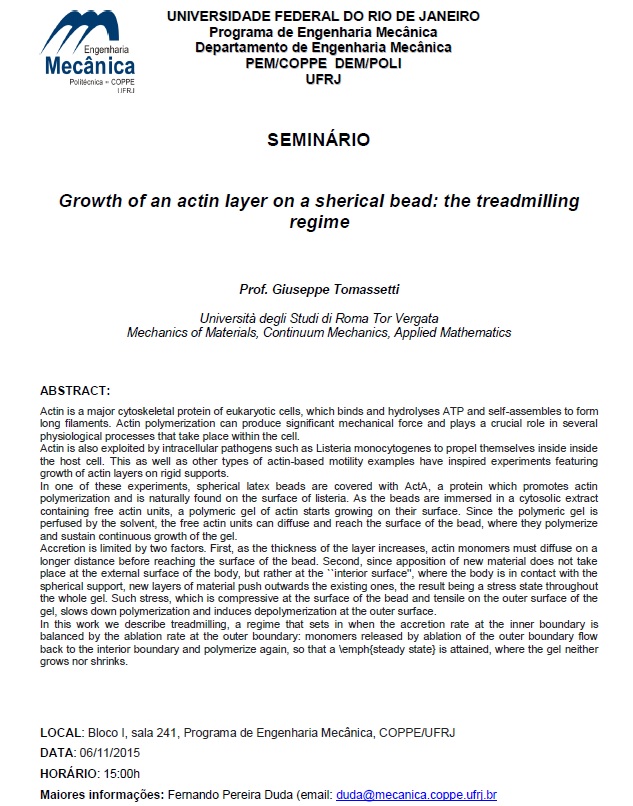Palestrante: Prof. Giuseppe Tomassetti, Università degli Studi di Roma Tor Vergata
Mechanics of Materials, Continuum Mechanics, Applied Mathematics
LOCAL: Bloco I, sala 241, Centro de Tecnologia, Ilha do Fundão
DATA: 06/11/2015
HORÁRIO: 15:00h
Maiores informações: Fernando Pereira Duda (email: Este endereço de email está sendo protegido de spambots. Você precisa do JavaScript ativado para vê-lo.)
ABSTRACT:
Actin is a major cytoskeletal protein of eukaryotic cells, which binds and hydrolyses ATP and self-assembles to form long filaments. Actin polymerization can produce significant mechanical force and plays a crucial role in several physiological processes that take place within the cell.
Actin is also exploited by intracellular pathogens such as Listeria monocytogenes to propel themselves inside inside the host cell. This as well as other types of actin-based motility examples have inspired experiments featuring growth of actin layers on rigid supports.
In one of these experiments, spherical latex beads are covered with ActA, a protein which promotes actin polymerization and is naturally found on the surface of listeria. As the beads are immersed in a cytosolic extract containing free actin units, a polymeric gel of actin starts growing on their surface. Since the polymeric gel is perfused by the solvent, the free actin units can diffuse and reach the surface of the bead, where they polymerize and sustain continuous growth of the gel.
Accretion is limited by two factors. First, as the thickness of the layer increases, actin monomers must diffuse on a longer distance before reaching the surface of the bead. Second, since apposition of new material does not take place at the external surface of the body, but rather at the ``interior surface'', where the body is in contact with the spherical support, new layers of material push outwards the existing ones, the result being a stress state throughout the whole gel. Such stress, which is compressive at the surface of the bead and tensile on the outer surface of the gel, slows down polymerization and induces depolymerization at the outer surface.
In this work we describe treadmilling, a regime that sets in when the accretion rate at the inner boundary is balanced by the ablation rate at the outer boundary: monomers released by ablation of the outer boundary flow back to the interior boundary and polymerize again, so that a \emph{steady state} is attained, where the gel neither grows nor shrinks.


